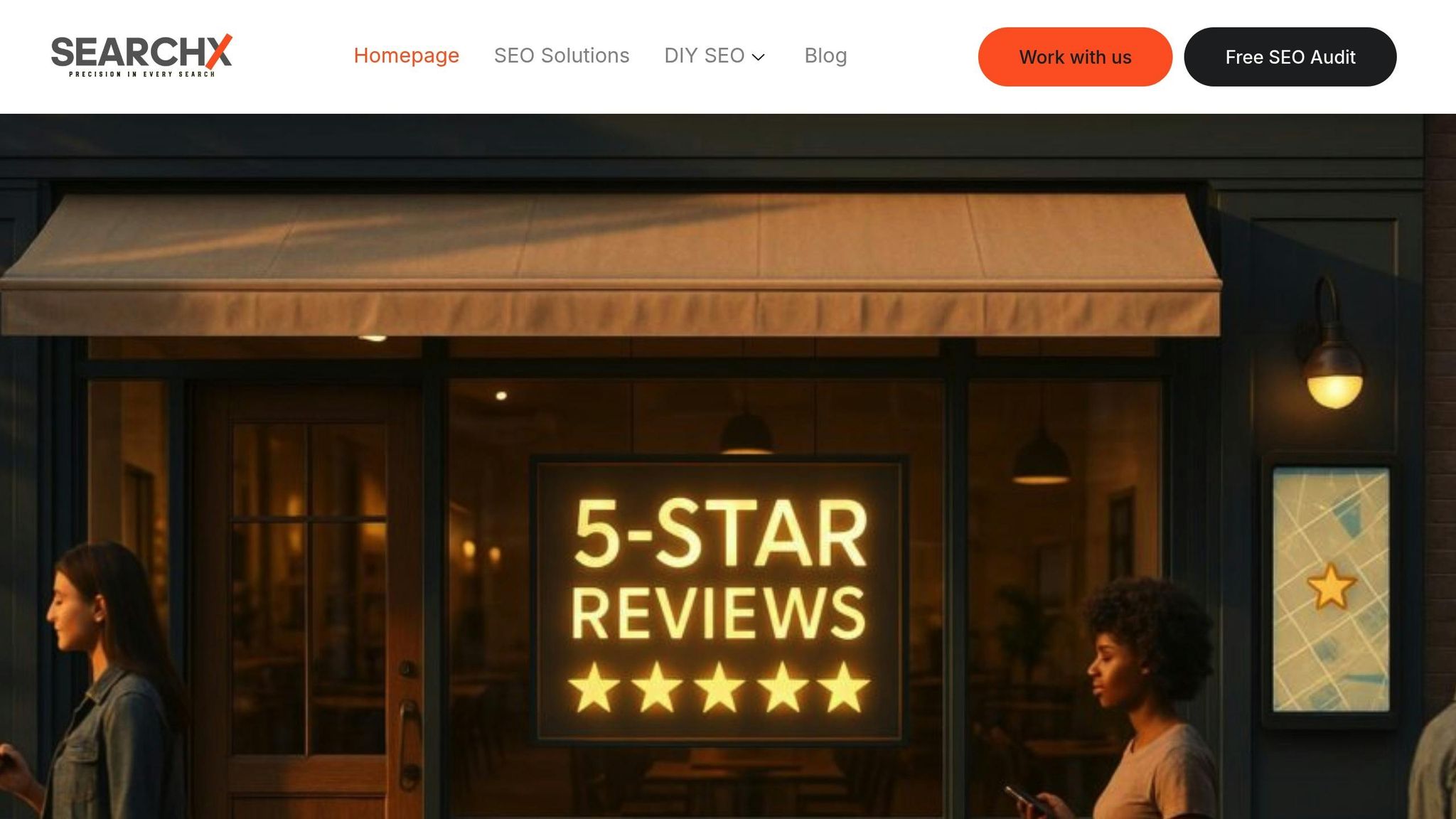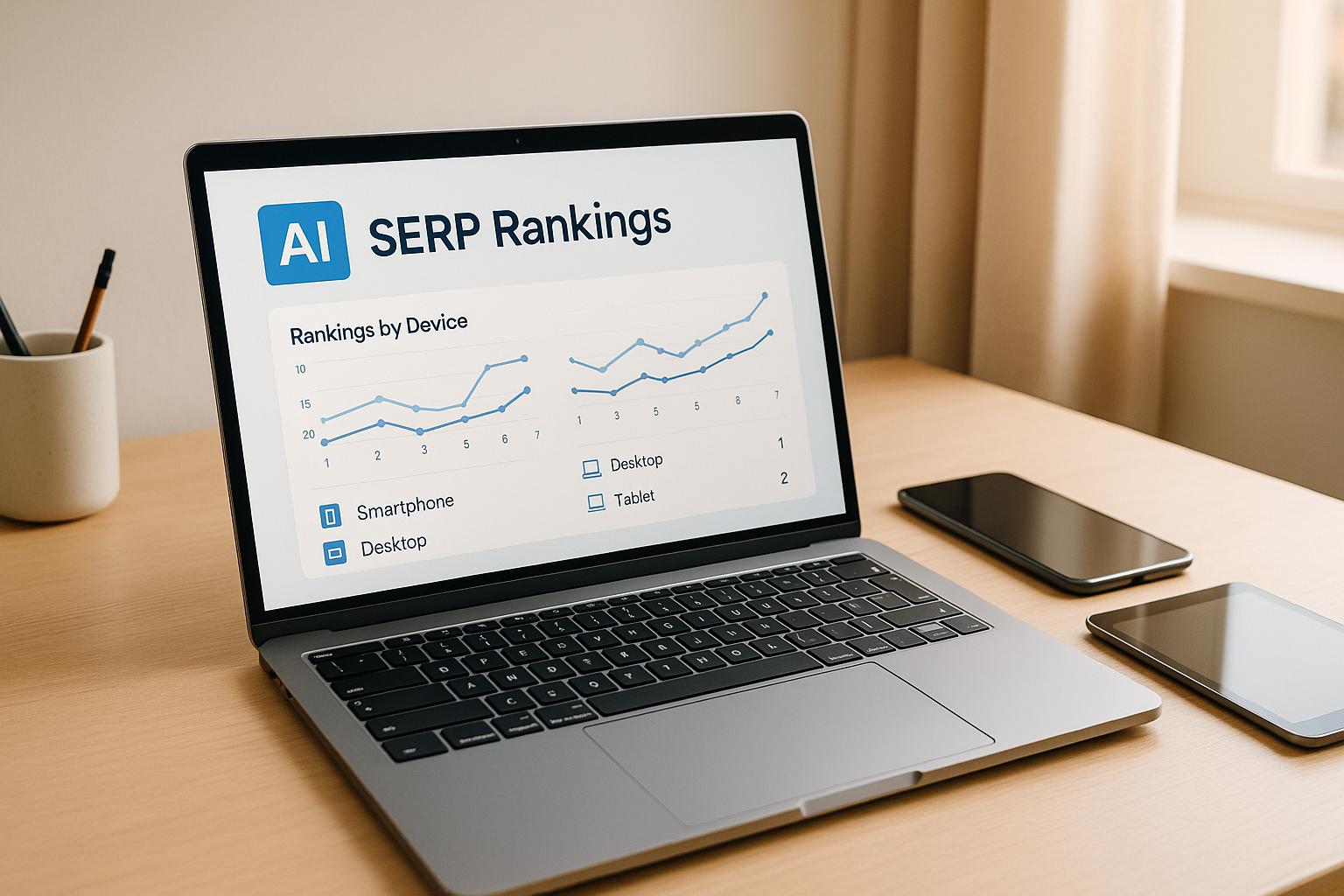Search engine results pages (SERPs) vary across devices like mobile, desktop, and tablets. Ignoring these differences can hurt your SEO strategy, especially since over 80% of searches in the U.S. happen on mobile devices. AI tools simplify tracking rankings across devices by providing real-time insights, identifying trends, and automating tedious tasks. Here’s what you need to know:
- Why it matters: Mobile SERPs often prioritize local results and quick answers, while desktop users may see more detailed content. Ignoring device-specific performance leads to missed opportunities.
- How AI helps: AI-powered tools automate keyword tracking, monitor changes in rankings, and analyze SERP features like local packs or AI summaries across devices.
- Steps to take: Use AI tools to track rankings by device, location, and keyword. Configure settings for U.S. standards (e.g., ZIP codes, language). Analyze data to adjust content for better performance.
- Advanced strategies: Focus on local SEO for mobile users, optimize for AI-driven SERP features, and use geolocation testing to improve visibility in specific areas.
Tracking SERP rankings across devices is no longer optional – it’s necessary to stay competitive in today’s search landscape.
Start building a Rank Tracking AI System with Claude + DataForSEO‘s MCP Server (for $0.002)

Getting Ready for Multi-Device SERP Tracking with AI
Before diving into tracking rankings across different devices, it’s essential to gather accurate data and configure your tools properly. A solid setup ensures that raw data becomes actionable insights you can rely on.
Data and Tools You Need
Start by collecting precise keywords, location targets, and device-specific parameters. These elements are the backbone of effective multi-device SERP tracking.
To begin, create a detailed keyword list that mirrors how your audience searches. This means going beyond basic product terms to include long-tail keywords, local variations, and search patterns unique to specific devices. For example, mobile users often use shorter, conversational queries, while desktop searches tend to be more detailed and lengthier.
Location targeting is another critical aspect, especially for businesses in the U.S. Decide whether to track rankings nationally, by state, or down to specific zip codes. For instance, a retail chain operating in New York, California, and Texas should monitor a keyword like "best running shoes" separately in each state. Why? Because local competition and search behavior can vary widely.
Don’t forget to configure device-specific parameters. Search engines often display different results depending on the device, so your tracking tool should capture rankings for each device category – mobile, desktop, and tablet – individually.
AI-powered platforms like SearchX can simplify this process. These tools automate keyword research, location targeting, and device segmentation, handling hundreds of keyword-location-device combinations with ease. This reduces manual workload and delivers real-time insights you can act on.
When selecting a tracking tool, prioritize features like geolocation testing, granular location targeting, and automated reporting. These capabilities ensure you’re gathering precise, device-specific data while saving time on tedious tasks.
Once your tools and data are ready, fine-tune the settings to align with U.S. regional and device-specific standards.
Device-Specific and U.S. Setup Requirements
To ensure accurate tracking across devices in the U.S., you’ll need to adjust your tools to reflect local standards and preferences.
First, configure your tools to use U.S. formatting – dates should follow the MM/DD/YYYY format, monetary values should include dollar signs ($) with commas for thousands and periods for decimals, and measurements should use Fahrenheit for temperature and miles for distance.
Location targeting should go beyond a blanket "United States" setting. Instead, focus on specific states, cities, or even zip codes. For example, a local business in Austin, Texas, should track rankings specifically for Austin, not the broader Texas area.
It’s also a good idea to validate your tool’s data by comparing it with manual local searches. Platforms that offer historical data and local SERP snapshots can help you confirm that your tracking tool is delivering accurate results.
Finally, set up automated reports to flag major changes in device-specific rankings or shifts in SERP features. This ensures you’re always up to date on critical movements in your search rankings.
Step-by-Step Guide to Tracking SERP Rankings Across Devices
Now that your tools are set up and your data is ready, it’s time to dive into tracking. This guide will walk you through setting up AI-powered SERP tracking, analyzing your results, and streamlining your reporting process.
Setting Up Your AI SERP Tracking Tool
Choose an AI-powered SERP tracking tool that supports multiple devices and U.S.-specific targeting. Once you’ve created an account, add your domain and focus on targeting specific U.S. locations – whether it’s a state, city, or even a ZIP code.
Next, input your target keywords. Focus on terms with high search volume and strong commercial intent within the U.S. market. Organize these keywords into campaigns based on factors like location or device type. This structure will help you track performance more effectively and fine-tune your SEO strategy for each device.
Now, configure key settings to ensure accurate tracking. Select English (en-US) as your language, set your precise U.S. location, and make sure to include all three device types: desktop, mobile, and tablet. If your tool supports tracking AI-generated SERP features, enable this option. Many modern tools allow you to monitor elements like AI Overviews, featured snippets, and map packs, which are increasingly important for visibility and click-through rates.
For example, businesses in the U.S. have seen improvements in mobile rankings and organic traffic by optimizing page speed and tweaking content layouts for mobile users.
Once everything is configured, start the tracking process. Most tools will begin collecting data immediately, though your first full reports might take 24–48 hours to generate.
Reading Device-Specific Ranking Data
With your tracking tool up and running, it’s time to analyze the data. Use the dashboard to filter ranking data by device and location, then observe how your keywords are performing over time.
Pay attention to differences in keyword rankings across desktop, mobile, and tablet. Look for patterns, such as shifts in rankings that prioritize mobile devices or changes based on local factors. Visual tools like charts and graphs can help you spot trends and fluctuations, making it easier to identify actionable opportunities.
It’s also helpful to compare your performance against competitors. This can reveal whether ranking changes are unique to your site or reflect broader industry trends. If you notice consistent patterns over weeks or months, it might signal the need for adjustments, such as refining your mobile strategy or updating your content.
Setting Up Automated Reports
Automating your reports can save time and ensure you’re always up-to-date on changes. Set up weekly or bi-weekly automated reports to strike the right balance between timely insights and manageable data.
Configure your reports to include device-specific breakdowns, so your team can quickly see how rankings differ across desktop, mobile, and tablet. You can also integrate these reports with tools like Google Data Studio (Looker) for easy sharing with stakeholders.
Set up alerts to notify you of significant changes, such as a keyword dropping five positions. These alerts allow you to act quickly, whether it’s addressing a potential issue or capitalizing on a new opportunity.
Tailor your reports to include metrics that matter most to your business, like ranking positions, appearances in SERP features, competitor movements, and local variations. You can also customize the frequency of reports based on the audience. For instance, executives might prefer a monthly summary, while SEO teams benefit from detailed weekly updates packed with actionable insights.
Finally, don’t forget to update your keyword list regularly. Incorporate seasonal trends and emerging topics, and segment your reports by device and location to gain deeper insights into your performance.
Advanced Strategies and Best Practices for U.S. Businesses
Once you’ve set up a solid multi-device tracking system, it’s time to refine your strategy. By diving deeper into multi-device data, U.S. businesses can gain insights that drive both local success and national expansion.
Using Multi-Device Data for Local and National SEO
To get the most out of your SERP tracking efforts, it’s essential to understand how user behavior and device preferences vary by location and search intent. A one-size-fits-all approach won’t cut it.
Start by segmenting your data geographically. For instance, a restaurant chain might notice lower mobile rankings in cities like New York and Los Angeles. This could signal the need for targeted mobile optimizations in those areas. Tracking rankings by device and location – even down to specific ZIP codes – can reveal regional opportunities and highlight mobile-specific issues like slow site speed or mismatched content.
For local SEO, prioritize mobile performance in key markets. Mobile users are more likely to perform "near me" searches, so identify areas where mobile rankings lag behind. Then, focus on improvements such as faster mobile loading times, updated local listings, and content tailored for mobile users.
On a national level, analyze device trends across multiple markets. For example, some keywords might perform better on desktop than mobile. Use this data to shape your content strategy – creating detailed, research-heavy articles for desktop users and quick, straightforward answers for mobile searchers.
Geolocation testing is another game-changer for franchises or businesses with multiple locations. By simulating searches from different areas and devices, you can ensure each location maintains strong visibility where it matters most.
These tactics lay the groundwork for tackling the next big challenge: AI-driven SERP features.
Tracking AI-Generated SERP Features
The search landscape is shifting rapidly with the rise of AI-generated content blocks, summaries, and other dynamic SERP elements. These features can significantly impact the visibility of traditional organic results.
AI-generated overviews and dynamic content blocks often appear differently on mobile versus desktop. To stay ahead, configure your tools to track AI summaries, featured snippets, and local packs. This gives you a clearer picture of which content is earning these coveted spots.
To improve your chances of being featured in AI-generated summaries, focus on structured data and FAQ sections. These elements not only enhance your visibility but can also drive higher click-through rates. Ensure your tracking reports include metrics on SERP feature appearances across devices to provide a complete view of your search performance.
With these advanced strategies in place, businesses can scale their multi-device SEO efforts effectively.
How SearchX Supports Multi-Device SEO at Scale

Managing multi-device SERP tracking across numerous locations, keywords, and markets can quickly become overwhelming. That’s where specialized solutions like SearchX come in, offering tailored strategies that align with your business goals.
SearchX doesn’t rely on cookie-cutter solutions. Instead, they use your specific market conditions and device performance data to craft strategies that deliver results – whether you’re managing a single location or a nationwide franchise network.
For franchises, SearchX offers centralized tracking and reporting, ensuring consistency across locations while allowing for local customization. Their system can handle large volumes of keywords across multiple devices and regions, helping you spot opportunities and address issues before they affect your bottom line. This is especially valuable in competitive markets where ranking shifts can directly impact revenue.
Their expertise extends to understanding local nuances. For example, they know mobile users in Charleston, SC, might behave differently than those in Miami, FL, and they adjust strategies accordingly. By combining national SEO insights with local data, they help businesses maintain visibility across all devices and locations.
SearchX’s team doesn’t just deliver reports – they actively use multi-device data to refine strategies. Their focus is on improving rankings, driving qualified traffic, and boosting revenue. Acting as an extension of your team, they prioritize measurable outcomes over generic SEO checklists.
For e-commerce businesses, they offer tailored strategies for platforms like Shopify and Amazon. Recognizing that device preferences vary by product type, they adapt their SEO tactics to meet the unique demands of local and national markets.
Their comprehensive approach also includes tracking AI-driven SERP features and ensuring technical SEO elements work seamlessly across devices. With offices in Charleston, New York, Miami, and Austin, they bring a deep understanding of regional search patterns, offering insights that automated tools might miss.
SearchX’s transparent reporting and full campaign visibility ensure you always know how your SEO efforts are driving business growth. This allows you to focus on running your business, confident that your search visibility is in expert hands.
Key Takeaways for Multi-Device SERP Tracking
In 2025, multi-device SERP tracking powered by AI is essential for businesses in the U.S. With over 80% of online searches now happening on mobile devices, understanding how your content performs across desktop, mobile, and tablet platforms is no longer optional – it’s a necessity for staying competitive.
AI-powered tracking tools have become a major step forward from older methods. These tools offer real-time data, automated analysis, and actionable insights, enabling businesses to respond quickly to ranking changes across all devices. By automating data processing and identifying trends, these tools eliminate the inefficiencies of manual tracking and provide a clear edge.
Geographic segmentation has become a standout feature for both local and national SEO strategies. Tracking rankings at the ZIP code level and analyzing device preferences by location uncover regional opportunities without requiring repetitive setup. This granular approach is particularly useful for franchises and multi-location businesses that operate across diverse U.S. markets.
AI-generated SERP features like featured snippets, local packs, and AI-driven summaries add another layer of complexity. These elements often display differently depending on the device, creating new opportunities for optimization. Businesses that monitor these features and adjust their content strategies accordingly can secure high-visibility spots on search results pages.
Managing costs and scalability is just as important as technical adjustments. Focusing on your most critical keywords and locations first – and scaling up based on results – helps control expenses while maximizing impact. Many affordable and scalable tools make it easier for businesses to adopt comprehensive tracking without breaking the bank.
Specialized expertise is becoming increasingly important for managing multi-device tracking across multiple locations, keywords, and markets. Agencies like SearchX offer tailored solutions that blend national SEO strategies with local market insights. This approach ensures businesses maintain visibility across all devices while focusing on measurable outcomes.
"We don’t believe in cookie-cutter solutions or one-size-fits-all tactics. Instead, we bring our expertise to the table to tailor a strategy that fits your unique goals." – SearchX
Automated reporting is another game-changer, simplifying updates and enabling quick responses to ranking shifts. This is particularly valuable in competitive markets, where timely adjustments can directly influence growth.
Success in multi-device SERP tracking requires an ongoing commitment. Regular audits, continuous optimization based on data insights, and alignment with broader business objectives can improve local visibility, boost national rankings, and increase conversions across all devices. These strategies highlight the importance of treating multi-device SEO as an evolving initiative rather than a one-time effort.
FAQs
How can AI tools help track SERP rankings on desktop, mobile, and tablet devices more effectively?
AI tools make it easier to keep track of your SERP rankings across various devices by automating data collection and providing detailed, device-specific insights. They help you understand how your website performs on desktops, mobile phones, and tablets, giving you a clear picture of ranking differences and user behavior on each platform.
With AI, spotting trends, identifying ranking changes, and fine-tuning your strategy for specific devices becomes much faster. This approach ensures your SEO efforts are tailored to how users engage with your site, helping boost your online visibility and deliver stronger results.
What should U.S.-based businesses focus on when setting up SERP tracking for multiple devices?
When setting up SERP tracking for desktop, mobile, and tablet devices, it’s crucial to pay attention to a few important areas:
- Keyword Selection: Focus on keywords that match your audience’s intent and have the potential to attract meaningful traffic to your site. The right keywords can make all the difference in connecting with your target audience.
- Device-Specific Insights: Track rankings separately for desktop, mobile, and tablet platforms. This helps you see how your site performs on each device, revealing any gaps or opportunities for improvement.
- Content and Technical Optimization: Make sure your content is relevant and aligned with search engine requirements. At the same time, address technical SEO factors like mobile responsiveness and page speed to ensure a smooth user experience across all devices.
By focusing on these areas, you’ll be able to monitor and refine your rankings effectively, no matter which device your audience is using.
How do AI-powered SERP features like summaries and local packs influence my website’s visibility, and how can I optimize for them?
AI-powered SERP features, like summaries and local packs, significantly influence your website’s visibility by delivering quick answers and localized results directly on the search results page. While these features can lower click-through rates for certain queries, they also ramp up the competition for grabbing attention.
To improve your chances of appearing in these features, focus on creating relevant, user-focused content that directly addresses what people are searching for. Use structured data (schema markup) to help search engines interpret your content more effectively and boost its likelihood of being showcased. On top of that, make sure your website is in great technical shape – prioritize fast loading times, mobile-friendly design, and adherence to the latest SEO practices.




